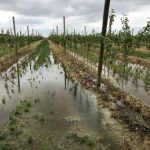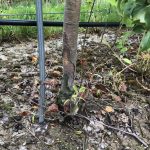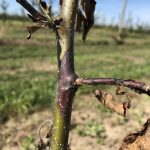Even in the most successful and best run orchards, trees die. A small percent is considered the norm, and is unavoidable (accepting this is a different story). However, in some years, more trees have succumb than usual. Growers need to determine what caused tree death–or at least rule out some potential pests or pathogens that could spread throughout the orchard—in order to manage and mitigate damage. Fortunately or unfortunately, many tree problems are abiotic (not caused by insects or pathogens) and are due to a complex interaction of environmental conditions. Plant pathogens and pests may contribute to many of these problems, but may not be the root cause (pun intended).
Since the beginning of this season, multiple problems were reported from orchards across the state. There are several ways in which the environment can adversely affect trees, almost all of which can occur within Indiana (and even in the same day). This is important to keep in mind because many of these problems are being attributed to winter injury, fire blight, and/or Phytophthora. Winter injury may have certainly played a role in what we are observing (and was discussed in previous issues of FFF), but there are other factors at play. Symptoms of winter injury include inconsistent, slow, and clumpy budbreak, which was reported throughout the state. This spring, trees were slow to leaf out, and when they did so, it was erratic (which was good because it protected trees from subsequent freezes and total crop loss). Emerging shoots were clustered, and leaves didn’t elongate well, giving trees a tufted appearance (Fig. 1).
At the same time, many parts of the state were really dry, with below average precipitation. This lack of water prevented good foliar development and trees maintained that tufted, ‘unthrifty’ appearance. Not obtaining sufficient water prevents proper photosynthesis, resulting in plants that thirsty AND hungry—and not developing appropriately. However, in half the orchards examined here, irrigation was provided earlier in the 2020 season, which should have mitigated some of the drought impacts.
When we add the sudden, extreme heat that began in late May to this mix, trees displayed drought symptoms, even when moisture was available after any significant rainfall. For trees, water is used not only to photosynthesize and create food, but it is essential for cooling leaf surfaces via evapotranspiration. Any damage that occurs before rainfall will not be corrected by subsequent rainfall—the damage has been done. Some leaves will remain small and/or scorched. Remember: Trees do not heal. Problems may be outgrown, but once any of these symptoms (leaf scorch, discoloration, dieback or death) occur, changes in environment may stop their progression but they can’t turn back the clock. Plants may recover by growing new leaves and shoots, but they won’t ‘heal.’
If all that wasn’t enough, many of us throughout the state and region experienced some significant flooding. Flooding damages trees in a multitude of ways, some of which are acute (severe, but only for a short period) (Fig. 2) while others may create chronic (long lasting) problems. Flooding that keeps trees submerged for days at a time create acute damage, that consists of dying, leaking roots. These leaky roots are high susceptible to root rots, especially Phytophthora spp. What is often not considered is the long-term stress and problems that result in consistent, above average rainfall. Trees continue to grow in the presence of water, sunlight, and soil nutrients. When water is plentiful, root development does not have to be as extensive as average to dry years to obtain the water necessary to support canopy growth. When conditions change to normal or to drier conditions, trees fail to have the roots to transport water to the crowns. Crowns fail to have the water to photosynthesize and feed roots. This can create a feedback loop of failure: Droughty, dying crowns fail to provide photosynthate to roots, which in turn, are unable to provide sufficient water to maintain canopy. Dieback continues until a balance is reached. If it isn’t reached, the tree may continue its decline feedback loop to death.
If all this wasn’t enough, many of the tree affected are presenting incompatible grafts (Fig 3). This cultivar-rootstock incompatibility is described as resulting in breaks or malformations at the graft union, leaf chlorosis, early defoliation, plant wilt, and premature death. This is different from other reports of problems affecting G.935, in that trees aren’t experiencing a decline, but fairly rapid death. In the orchards examined with G.41 rootstock, incompatibility presented as snappage (Fig. 4), with or without decline of the tree prior to complete breakage.
What it isn’t
There has been a lot of conjecture and discussion regarding all sorts of problems given a variety of acronyms (Rapid Apple Death (RAD), Sudden Apple Death(SAD), Fake apple death(FAD—I jest). Naming something is very different than understanding it, and in fact, naming something early often cements incorrect assessments, assumptions, and diagnoses. What we are seeing seems to be quite different than what was reported on the East coast.
Table 1. Compare and contrast of apple maladies, Midwest versus East Coast
| Symptoms | Indiana | East Coast |
| Cultivar affected | Gala, Honeycrisp | Fuji, Gala, and Golden Delicious |
| Scion | Cankers by graft union, with dieback and decline | Death extends from graft |
| Rootstocks Involved | M.9, Nic29, G935, G41
Rootstock is alive and appears healthy |
Rootstock is healthy(?); M9 and others
|
| Age of trees | Under 5 years | unknown |
| Foliage | Unthrifty, yellowing, poorly developed, tufting. May begin to recover, only to turn brown and die (Fig 1) | Pale yellow turning red and soon dying
|
| Graft Union | Appears healthy in some blocks; snappage in others (Fig. 4) | Cankers, bark slough |
| Irrigated Block | Yes 3 of 4 blocks | Unknown |
| Herbicides | Drift issues may be involved 2 of 4 orchards (Fig 5). | Unknown |
| Weather | Drought (April-June 30/2020) | Drought (2019) |
| Winter injury | Winter injury | |
| Flooding history(2019) | ? | |
| Patterns | Clustering | dead, declining and healthy trees evenly dispersed in blocks |
| Borer/Ambrosia beetle | Not observed | detected |
| Cankers | Black rot, white rot (Fig. 6) | White rot |
| Root rot | 1 of 4 orchards | Not detected |
| Virus | Unknown | In healthy and symptomatic trees |
| Fire blight | Not detected in 2020; previously reported in 2 of 4 orchards | Not detected |
| Nematodes | Not tested, healthy suckers | Inconsistent, but mostly healthy suckers |
| History of overcropping | A problem with Honeycrisp; inconsistent | Unknown |
| Rodent and rabbit damage | Present but at low levels | Unknown |
Managing Young Plantings of Declining Trees
As there are a lot of factors at play, growers need to recognize which ones may be occurring in their own orchard. Here are some of the more common stressors observed this year, and suggested management option.
Crop Management
Most of the orchards examined lost the majority of the crop with the multiple spring freezes that occurred in April and May. This may be a blessing in disguise and prevented even greater losses than what has been observed to date. However, for next year, trees will need to be thinned to prevent overcropping and additional physiological stress, particularly on trees with grafting issues like are seen with G.41 and G.935, or trees in sites that were very wet in 2019. Crop thinning will reduce the likelihood of snappage or topple. See the Midwest Fruit Pest Management Guide for more information on thinning: https://ag.purdue.edu/hla/hort/documents/id-465.pdf
Fertilize
It is particularly important that winter injured stands have adequate fertility, however, half of the orchards reporting problems may have applied more N fertilizer than is recommended. A fruit tree that is overfertilized will produce an excess of succulent new growth. This succulent growth is more susceptible to not only fire blight, but root rots like Phytophthora, too. If fertilizer is applied too late in the season, trees may not harden off properly, predisposing them to winter injury.
Fertilizer requirements vary due to differences in soil profiles, rootstock/tree size choices, and other cultural and pest management practices. However, after year one, a general rule of thumb is to apply 0.02 pound of actual nitrogen per year/age of the planting/orchard up until 0.2 pound (year 10). As different fertilizers have different percentages of nitrogen, use Table 1 to assist in obtaining the appropriate N levels. After (approximately) year ten, leaf analysis results and corresponding shoot growth assessment should be taken before adding any nitrogen fertilizer. Nutrient concentrations in plant tissues are the most accurate indicator of the nutritional health of fruit tree crops.
Table 1. Sources of nitrogen, percent nitrogen content and application rates.
| Nitrogen source | Nitrogen content | Actual amount of material to apply per tree |
| Ammonium nitrate | 33% | 0.06 lb or 0.97 oz or 28 g |
| Ammonium sulfate | 21% | 0.09 lb or 1.5 oz or 43 g |
| Mono-ammonium phosphate(MAP) | 11% | 0.18 lb or 2.9 oz or 83 g |
| Di-ammonium phosphate (DAP) | 18% | 0.11 lb or 1.8 oz or 50 g |
| Calcium nitrate | 15.50% | 0.13 lb or 2.1 oz or 59 g |
| Sodium nitrate | 16% | 0.125 lb or 2.0 oz or 57 g |
| Urea | 46% | 0.04 lb or 0.7 oz or 20 g |
| 19-19-19 | 19% | 0.10 lb or 1.7 oz or 48 g |
| 10/10/10 | 10% | 0.20 lb or 3.2 oz or 91 g |
Weed control
Herbicide applications help control weeds if applied to the weeds and not the trees or rootstocks. Many growers have moved away from RoundUp and other glyphosate based products due to the systemic nature of the herbicide. Instead growers have relied heavily on the contact herbicides glufosinate and paraquat. The label of these glufosinate herbicides state “Avoid direct spray or drift to desirable vegetation” and the “solution, spray, drift or mist with green bark, stems, or foliage, as injury may occur to trees, vines, and berries. Only trunks with callused, mature brown bark should be sprayed unless protected from spray contact by nonporous wraps, grow tubes, or waxed containers. Contact … with parts of trees, vines, or berries other than mature brown bark can result in serious damage.” (underlines mine) (Fig. 5). Half the growers had both weed control issues that necessitated higher rates of herbicide, which in turn, may have made any drift to rootstock or scion that much more damaging. This holds true for paraquat based herbicides as well, with the label stating “Do not allow spray to contact green stems (except suckers), fruit or foliage.”
When using glufosinate or paraquat to control weeds in an orchard, apply herbicides with a low pressure (20-30 psi) to create larger droplets with less likelihood of drift and/or include a drift-control agent (e.g., Chemtrol, Strikezone or Windcheck) to minimize the risk of small droplets drifting to rootstocks and graft union. If possible, apply herbicides with a hooded boom sprayer. If grasses are a problem, use grass-specific herbicides instead, and begin incorporating a pre-emergent to reduce the risk of herbicide injury by reducing the need to treat blocks.
Sucker Punch…er…Pruning
Some cultivars are more prone to suckering than others, with M.7, M.9 more prone to suckering than B.9, or EMLA 26. The pruning of suckers by either chemical or mechanical means may be contributing to the problems we are observing (Fig. 5). Suckering is an indication that scion portion of the tree is not functioning as well as it can. Suckers provide rootstock with photosynthates (food), redirecting the root stock to deliver water and nutrients to the sucker and not the scion depriving the scion of water and nutrients. Removing those large suckers creates an wound that is more susceptible to herbicide injury and frost cracking, and can become infected with Phytophthora, Erwinia (the fire blight pathogen), and the bot cankers (Fig. 6). If that wasn’t bad enough the rootstock is no longer obtain the photosynthesis it once received, just adding to the stress situation.
Another option would be to chemically control root suckers via NAA (naphthaleneacetic acid; e.g., Tre-Hold® Sprout Inhibitor A112c with a brush, small hand held sprayer or back pack sprayer. For large projects, power operated low-pressure spray equipment with attached hand gun or trunk directed nozzle can be used. Maintain low spray pressure (not to exceed 25psi) to avoid spray drift of fine spray particles. NAA works to restore apical dominance of the scion, suppressing root suckering. Be aware that NAA is also a fruit-thinning agent: To minimize the risk of possible thinning by NAA from spray drift, apply ~4 weeks after petal fall or when fruit are larger than 10mm or when regrowth is 6–12 inches tall.
Strengthening the Union
Lastly, recent work has found that one to two applications of Maxcell (benzyl adenine, BA) at a concentration of 2.5 g/l in latex paint applied to the graft union increased the strength and flexibility of the graft union relative to scion cross sectional area (SCSA) in one study, but further research is needs to identify more efficient methods of application(Adams 2016).
The NC-140 group that oversees the rootstock evaluation found that Apogee also increased strength but reduced scion growth. Do not apply any PGR if using NAA for sucker control.
Final thoughts
It is important to remember that no one factor caused these problems, and that multiple, integrated approaches are needed to correct some of the issues at play that can be corrected. There isn’t much we can do about the weather, beyond tiling and irrigating. We can research rootstocks to make the best decision for our scion, site and pest issues (more on that soon). Mindful herbicide use, particularly with young trees and thinned bark scions like Honeycrisp, Gala, and Blondee, will minimize the risk of injury to scion, graft and rootstock, while controlling weeds, and preventing habitat for rabbits and rodents.
- Figure 1
- Figure 2
- Figure 3
- Figure 4
- Figure 5
- Figure 6
Literature Cited
Adams, S.W. 2016. The Effects of Rootstock, Scion, Grafting Method and Plant Growth Regulators on Flexural Strength and Hydraulic Resistance of Apple. Available online at: https://digitalcommons.usu.edu/etd/5075/ Last accessed 7/24/2020.
Dupont, T. 2018. 2017 Geneva Rootstock Tour Observations. Available online at: http://treefruit.wsu.edu/article/2017-geneva-rootstock-tour-observations/#_ftn2. Last accessed 7/24/2020.
Singh J, Silva KJP, Fuchs M, Khan A (2019) Potential role of weather, soil and plant microbial communities in rapid decline of apple trees. PLoS ONE 14(3): e0213293. https://doi.org/10.1371/journal.pone.0213293





